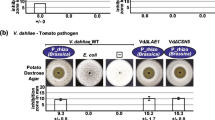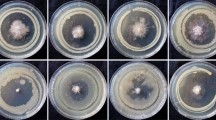Abstract
The mechanisms of suppression of fusarium wilt of carnation by two fluorescentPseudomonas strains were studied.
Treatments of carnation roots withPseudomonas sp. WCS417r significantly reduced fusarium wilt caused byFusarium oxysporum f. sp.dianthi (Fod). Mutants of WCS417r defective in siderophore biosynthesis (sid−) were less effective in disease suppression compared with their wild-type. Treatments of carnation roots withPseudomonas putida WCS358r tended to reduce fusarium wilt, whereas a sid− mutant of WCS358 did not.
Inhibition of conidial germination of Fod in vitro by purified siderophores (pseudobactins) of bothPseudomonas strains was based on competition for iron. The ferrated pseudobactins inhibited germination significantly less than the unferrated pseudobactins. Inhibition of mycelial growth of Fod by bothPseudomonas strains on agar plates was also based on competition for iron: with increasing iron content of the medium, inhibition of Fod by thePseudomonas strains decreased. The sid− mutant of WCS358 did not inhibit Fod on agar plates, whereas the sid− mutants of WCS417r still did. This suggests that inhibition of Fod by WCS358r in vitro was only based on siderophore-mediated competition for iron, whereas also a non-siderophore antifungal factor was involved in the inhibition of Fod by strain WCS417r.
The ability of thePseudomonas strains to induce resistance against Fod in carnation grown in soil was studied by spatially separating the bacteria (on the roots) and the pathogen (in the stem). Both WCS417r and its sid− mutant reduced disease incidence significantly in the moderately resistant carnation cultivar Pallas, WCS358r did not.
It is concluded that the effective and consistent suppression of fusarium wilt of carnation by strain WCS417r involves multiple mechanisms: induced resistance, siderophore-mediated competition for iron and possibly antibiosis. The less effective suppression of fusarium wilt by WCS358r only depends on siderophore-mediated competition for iron.
Similar content being viewed by others
References
Baayen, R.P., 1986. Regeneration of vascular tissues in relation to Fusarium wilt resistance of carnation. Netherlands Journal of Plant Pathology 92: 273–285.
Baayen, R.P. & Elgersma, D.M., 1985. Colonization and histopathology of suceptible and resistant carnation cultivars infected withFusarium oxysporum f.sp.dianthi. Netherlands Journal of Plant Pathology 91: 119–135.
Bakker, P.A.H.M., Bakker, A.W., Marugg, J.D., Weisbeek, P.J. & Schippers, B., 1987. Bioassay for studying the role of siderophores in potato growth stimulation byPseudomonas spp. in short potato rotations. Soil Biology and Biochemistry 19: 443–449.
Bakker, P.A.H.M., Lamers, J.G., Bakker, A.W., Marugg, J.D., Weisbeek, P.J. & Schippers, B., 1986. The role of siderophores in potato growth stimulation byPseudomonas putida in a short rotation of potato. Netherlands Journal of Plant Pathology 92: 249–256.
Bakker, P.A.H.M., Peer, R. van & Schippers, B., 1990. Specificity of siderophores and siderophore receptors and biocontrol byPseudomonas spp. In: Hornby, D., Cook, J., Henis, Y., Ko, W.H., Rovira, A.D., Schippers (Eds), Biological control of soil-borne plant pathogens. CAB International, Walingford, p. 131–142.
Bakker, P.A.H.M., Weisbeek, P.J. & Schippers, B., 1988. Siderophore production by plant growth-promotingPseudomonas spp. Journal of Plant Nutrition 11: 925–933.
Buyer, J.S., Sikora, L.J. & Chaney, R.L., 1989. A new growth medium for the study of siderophore-mediated interactions. Biology and Fertility of Soils 8: 97–101.
Duijff, B.J., Meijer, J.W., Bakker, P.A.H.M. & Schippers, B., 1991. Suppression of Fusarium wilt of carnation byPseudomonas in soil; mode-of-action. In: Keel, C., Koller, B. & Défago, G. (Eds), Plant Growth-Promoting Rhizobacteria: Progress and Prospects. IOBC/WPRS Bulletin XIV. p. 152–157.
Gams, W. & Laar, W. van, 1982. The use of solacol (validamycine) as a growth retardant in the isolation of soil fungi. Netherlands Journal of Plant Pathology 88: 39–45.
Geels, F.P. & Schippers, B., 1983. Selection of antagonistic fluorescentPseudomonas spp. and their root colonization and persistence following treatment of seed potatoes. Phytopathologische Zeitschrift 108: 193–206.
Gill, P.R. & Warren, G.J., 1988. An iron-antagonized fungistatic agent that is not required for iron assimilation from a fluorescent rhizosphere pseudomonad. Journal of Bacteriology 170: 163–170.
Glandorf, D.C.M., Brand, I., Bakker, P.A.H.M. & Schippers, B., 1992. Stability of rifampicin resistance as a marker for root colonization studies ofPseudomonas putida in the field. Plant and Soil 147: 135–142.
Gutterson, N., 1990. Microbial fungicides: recent approaches to elucidating mechanisms. Critical Reviews in Biotechnology 10: 69–91.
King, E.O., Ward, M.K. & Raney, D.E., 1954. Two simple media for the demonstration of pyocyanin and fluorescin. Journal of Laboratory and Clinical Medicine 44: 301–307.
Komada, H., 1975. Development of a selective medium for quantitative isolation ofFusarium oxysporum from natural soils. Review Plant Protection Research 8: 114–125.
Lamers, J.G., Schippers, B. & Geels, F.P., 1988. Soil-borne diseases of wheat in the Netherlands and results of seed bacterization with pseudomonads againstGaeumannomyces graminis var.tritici. In: Jorna, M.L. & Slootmaker, L.A.J. (Eds), Cereal Breeding Related to Integrated Cereal Production. Pudoc, Wageningen. p. 134–139.
Lemanceau, Ph. & Alabouvette, C., 1991. Biological control of fusarium diseases by fluorescentPseudomonas and nonpathogenicFusarium. Crop Protection 10: 279–286.
Lemanceau, Ph., Bakker, P.A.H.M., De Kogel, W., Alabouvette, C. & Schippers, B., 1992. Effect of pseudobactin 358 production byPseudomonas putida WCS358 on suppression of fusarium wilt of carnations by nonpathogenicFusarium oxysporum Fo47. Applied and Environmental Microbiology 58: 2978–2982.
Lindsay, W.L. & Schwab, A.P., 1982. The chemistry of iron in soils and its availability to plants. Journal of Plant Nutrition 5: 821–840.
Loper, J.E. & Buyer, J.S., 1991. Siderophores in microbial interactions on plant surfaces. Molecular Plant-Microbe Interactions 4: 5–13.
Loper, J.E. & Lindow, S.E., 1991. A biological sensor for available iron in the rhizosphere. In: Keel, C., Koller, B. & Défago, G. (Eds), Plant Growth-Promoting Rhizobacteria: Progress and Prospects. IOBC/WPRS Bulletin XIV, p. 177–181.
Marugg, J.D., Spanje, M. vna, Hoekstra, W.P.M., Schippers, B. & Weisbeek, P.J., 1985. Isolation and analysis of genes involved in siderophore biosynthesis in plant-growth-stimulatingPseudomonas putida WCS358. Journal of Bacteriology 164: 563–570.
Meijer, J.M. & Abdallah, M.A., 1978. The fluorescent pigment ofPseudomonas fluorescens: biosynthesis, purification and physicochemical properties. Journal of General Microbiology 107: 319–328.
Niemann, G.J. & Baayen, R.P., 1988. Involvement of phenol metabolism in resistance ofDianthus caryophyllus toFusarium oxysporum f. sp.dianthi. Netherlands Journal of Plant Pathology 94: 289–301.
O'Sullivan, D.J. & O'Gara, F., 1992. Traits of fluorescentPseudomonas spp. involved in suppression of plant root pathogens. Microbiological Reviews 56: 662–676.
Pegg, G.F., 1985. Life in a black hole—the micro-environment of the vascular pathogen. Transactions of the British Mycological Society 85: 1–20.
Reid, R.K., Reid, C.P.P., Powell, P.E. & Szaniszlo, P.E., 1984. Comparison of siderophore concentrations in aqueous extracts of rhizosphere and adjacent bulk soils. Pedobiologia 26: 263–266.
Schippers, B. 1992. Prospects for management of natural suppressiveness to control soilborne pathogens. In: Tjamos, E.C., Papavizas, G.C. & Cook, R.J. (Eds), Biological control of plants diseases. Progress and challenges for the future. Plenum Press, New York, London. p. 21–34.
Schippers, B., Lugtenberg, B. & Weisbeek, P.J., 1987. Plant growth control by fluorescent pseudomonads. In: Chet, J. (Ed.), Innovative approaches to plant disease control. wiley and Sons, New York. p. 19–36.
Schwyn, B. & Neilands, J.B., 1987. Universal chemical assay for the detection and determination of siderophores. Analytical Biochemistry 160: 47–56.
Simeoni, L.A., Lindsay, W.L. & Baker, R., 1987. Critical iron level associated with biological control of Fusarium wilt. Phytopathology 77: 1057–1061.
Sokal, R.R. & Rohlf, F.J., 1981. Biometry. Freeman Publications, San Francisco. 859 pp.
Thomashow, L.S. & Weller, D.M., 1990. Role of antibiotics and siderophores in biocontrol of take-all disease of wheat. Plant and Soil 129: 93–99.
Van der Hofstad, G.A.J.M., Marugg, J.D., Verjans, G.M.G.M. & Weisbeek, P.J., 1986. Characterization and structural analysis of the siderophore produced by the PGPRPseudomonas putida strain WCS358. In: Swinburne, T.R. (Ed.), Iron Siderophores and Plant Disease. Plenum Press, New York. p. 71–75.
Van Peer, R., Kuik, A.J. van, Rattink, H. & Schippers, B., 1990. Control of Fusarium wilt in carnation grown on rockwool byPseudomonas sp. strain WCS417r and by FeEDDHA. Netherlands Journal of Plant Pathology 96: 119–132.
Van Peer, R., Niemann, G.J. & Schippers, B., 1991. Induced resistance and phytoalexin accumulation in biological control of Fusarium wilt of carnation byPseudomonas sp. strain WCS417r. Phytopathology 81: 728–734.
Van Peer, R. & Schippers, B., 1992. Lipopolysaccharides of plant-growth promotingPseudomonas sp. strain WCS417r induce resistance in carnation to Fusarium wilt. Netherlands Journal of Plant Pathology 98: 129–139.
Weller, D.M., 1988. Biological control of soilborne plant pathogens in the rhizosphere with bacteria. Annual Review of Phytopathology 26: 379–407.
Whitta, S., Sinclair, M.I. & Holloway, B., 1985. Transposon mutagenesis inMethylobacterium AM1 (Pseudomonas AM1). Journal of General Microbiology 131: 1547–1549.
Author information
Authors and Affiliations
Rights and permissions
About this article
Cite this article
Duijff, B.J., Meijer, J.W., Bakker, P.A.H.M. et al. Siderophore-mediated competition for iron and induced resistance in the suppression of fusarium wilt of carnation by fluorescent Pseudomonas spp. Netherlands Journal of Plant Pathology 99, 277–289 (1993). https://doi.org/10.1007/BF01974309
Accepted:
Issue Date:
DOI: https://doi.org/10.1007/BF01974309




